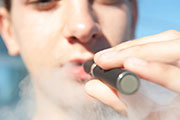

Concerns that e-cigarettes are a stepping stone to smoking for teens appear to have merit, new research suggests.
Los Angeles-area teenagers who had never smoked before were three to four times more likely to try cigarettes or other tobacco products after they’d experimented with an e-cigarette, according to the findings published in the Aug. 18 issue of the Journal of the American Medical Association.
“More teens have been using e-cigarettes for recreational uses, including teens who’ve never smoked before,” said study author Adam Leventhal, an associate professor of preventive medicine and psychology at the University of Southern California’s Keck School of Medicine in Los Angeles. “Because nicotine is such an addictive drug, it makes sense that if you enjoy the experience of inhaling nicotine, you might be more willing to experiment with other products that provide inhaled nicotine.”
This is the first study to show a potential link between e-cigarette use and smoking in teenagers, said Dr. Nancy Rigotti, director of the Tobacco Research and Treatment Center at Massachusetts General Hospital in Boston.
“It’s certainly a cause of concern, because it’s the first time we’ve seen that,” added Rigotti, who also is a professor at Harvard Medical School in Boston. “There’s been this theoretical concern this might happen, and this is the first time we’ve actually seen some evidence that it looks like it can happen.”
E-cigarettes have been presented by their manufacturers as a means to help adult smokers quit the habit, or at least provide a safer alternative to tobacco. The American Vaping Association, an e-cigarette industry group, asserts that the devices have helped several million adults quit smoking since their introduction nearly 10 years ago.
However, teenagers are trying e-cigarettes at a faster rate than adults, fueling some of the greatest increases in sales, Leventhal said. There currently are no federal regulations banning the sale or marketing of e-cigarettes to teens.
“These new e-cigarette devices are really efficient pieces of machinery. They heat these solutions to create aerosols that are rich with nicotine, so now they’re really effective at providing a shot of nicotine to the brain of a user,” Leventhal said.
To see whether e-cigarettes might lead to teen smoking, researchers recruited more than 2,500 ninth graders from 10 public high schools in Los Angeles.
Of those kids, none had ever tried smoking before but 222 said they had used an e-cigarette.
A year later, the kids who had tried e-cigarettes were roughly four times more likely to have tried smoking tobacco, compared with kids who hadn’t used an e-cigarette, the researchers found.
But because this was an observational study, the researchers couldn’t prove a cause-and-effect link between e-cigarette use and smoking, Rigotti noted. They also couldn’t say whether the kids who smoked had only tried one cigarette or had become regular smokers.
Gregory Conley, president of the American Vaping Association, a nonprofit that promotes vapor products, echoed Rigotti’s points.
“As the authors of the study admit, no attempt was made to measure habitual or even past month usage of either product, so the result should be interpreted with significant caution,” he said.
The researchers did, however, take into account other risk factors that increase a teenager’s chances of smoking, Leventhal noted. These included impulsive tendencies, depression, use of other drugs, and whether friends or family are smokers.
“We even straight-out asked the teens, ‘Do you think you are likely to smoke over the next six months, and would you try smoking if one of your best friends offered it to you?'” he said.
After controlling for these other risk factors, researchers discovered that teen e-cigarette users were still almost three times more likely than non-users to eventually graduate to smoking.
“These results were consistent across a number of different types of smokeable tobacco products, including regular cigarettes, cigars and hookah tobacco water pipes,” Leventhal said.
E-cigarette users also were more likely to have dabbled with at least two different types of smokeable tobacco, he added.
The study calls for prompt federal action, said Rigotti, who wrote an accompanying editorial. The U.S. Food and Drug Administration has proposed rules that would ban e-cigarette sales to people under the age of 18 and require warning labels, but those rules have not been finalized. The public comment period on those draft rules ended Aug. 8.
“The concern has been all along that they might attract young people,” Rigotti said. “There’s nobody who thinks it’s a good idea to addict a new generation to cigarettes or even to nicotine. These are nicotine delivery devices that are sold in ways that are very attractive to kids, and there’s no regulation on them at the moment.”
But e-cigarette manufacturers are concerned that regulation will go too far, and interfere with adults’ ability to use the devices as a means to help quit smoking, Conley said.
“Unfortunately, ardent opponents of vaping have a history of making wild and unsubstantiated claims, and this study will be twisted and used to push for unjustified excise taxes and small business-killing regulations,” he said.
“While reasonable measures to control youth access are warranted, all policy decisions about vaping must consider not just youth, but also the adults who would otherwise be smoking in the absence of these innovative technology products,” Conley noted.
More information
For more on e-cigarettes, visit the U.S. Food and Drug Administration.
Source: HealthDay
Copyright © 2025 HealthDay. All rights reserved.

Leave a Reply